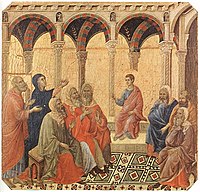Did Jesus Whole Family Go to Jerusalem When Jesus Was Twelve Years Old

The Finding in the Temple, as well called Christ among the Doctors or the Disputation (the usual names in art), was an episode in the early life of Jesus depicted in chapter ii of the Gospel of Luke. Information technology is the merely consequence of the later childhood of Jesus mentioned in a gospel.[1]
Gospel account [edit]
The episode is described in Luke 2:41–52. Jesus at the age of twelve accompanies Mary and Joseph, and a large group of their relatives and friends to Jerusalem on pilgrimage, "according to the custom" – that is, Passover. On the twenty-four hour period of their render, Jesus "lingered" /stayed in the Temple, simply Mary and Joseph idea that he was among their group when he wasn't. Mary and Joseph headed dorsum home and after a day of travel realised Jesus was missing, so they returned to Jerusalem, finding Jesus three days later.[2] He was plant in The Temple in discussion with the elders. They were amazed at his learning, especially given his young historic period. When admonished by Mary, Jesus replied: "How is it that you sought me? Did you non know that I must be in my Begetter's firm?"[3]
The story was slightly elaborated in later literature, such every bit the apocryphal 2nd-century Infancy Gospel of Thomas (19:i–12). The losing of Jesus is the third of the Seven Sorrows of Mary, and the Finding in the Temple is the fifth Joyful Mystery of the Rosary.[one]
In art [edit]

This event is oft shown in fine art, and was a common component in cycles of the Life of the Virgin as well equally the Life of Christ. In early Christian depictions, Jesus is usually shown in the middle, seated on a raised dais surrounded past the elders, who are often on stepped benches. The gesture usually made past Jesus, pointing to his upraised thumb (illustration), may be a conventional rhetorical gesture expressing the act of expounding text. These depictions derive from classical compositions of professors of philosophy or rhetoric with their students, and are similar to medieval depictions of contemporary academy lectures.
This composition can appear until every bit late as Ingres (Montauban, Musée Ingres [ane]) and across. From the Early on Medieval menstruation the moment shown is normally alloyed to the finding itself, past the inclusion of, initially, Mary, and later Joseph too, usually at the left of the scene. Typically, Jesus and the doctors, intent on their discussions, have not noticed them withal. From the 12th century Jesus is oftentimes seated in a big throne-similar chair, sometimes holding a book or curl.
In late medieval depictions, the Doctors, often now conveying or consulting big volumes, may be given specifically Jewish features or dress, and are sometimes overtly anti-Semitic caricatures, like some of the figures in Albrecht Dürer'south version in the Thyssen-Bornemisza Museum in Madrid. From the High Renaissance onward, many painters showed a "close-up" of the scene, with Jesus closely surrounded by gesticulating scholars, as in Dürer'south version of the subject.
Rembrandt, who enjoyed depicting Jewish elders in the Temple in various subjects, made three etchings of the subject (Bartsch 64–66) as well as ane of the much more than unusual scene of "Jesus returning from the Temple with his parents" (B sixty). The Pre-Raphaelite painter William Holman Chase painted a version chosen The Finding of the Saviour in the Temple, now at Birmingham, as one of a number of subjects from Jesus's life, for which he travelled to the Holy State to written report local details.
The subject field has attracted few artists since the 19th century, and one of the final notable depictions may exist the i painted, as a forgery of a Vermeer, by Han van Meegeren in front of the Dutch police, in social club to demonstrate that the paintings he had sold to Hermann Göring were also fake.
Gallery [edit]
-

This 15th-century page from a Volume of Hours shows the typical medieval composition of treatments on subject.
-

-

Disputation with the Doctors, betwixt 1308 and 1311, tempera on wood, Duccio di Buoninsegna
See too [edit]
- Seven Sorrows of Mary
References [edit]
- ^ a b "Fifth Joyful Mystery: The finding of Jesus in the temple", Vatican.va
- ^ The Bible Noesis Commentary: New Testament edition by John F. Walvoord, Roy B. Zuck 1983 ISBN 0-88207-812-7 p. 210
- ^ Other translations render Jesus' words "Why were you looking for me? Did you not know that I must be in my Father'due south house?" and "I must be about my Father's work." Run into "USCCB – NAB – Luke 2". Retrieved 2019-ten-19 .
Full general sources [edit]
- G. Schiller, Iconography of Christian Fine art, Vol. I, 1971 (English translation from German), Lund Humphries, London, pp. 124–5 & figs, ISBN 0-85331-270-2
External links [edit]
-
 Media related to Jesus Christ amid the doctors at Wikimedia Commons
Media related to Jesus Christ amid the doctors at Wikimedia Commons
Source: https://en.wikipedia.org/wiki/Finding_in_the_Temple#:~:text=7%20External%20links-,Gospel%20account,%22%20%E2%80%93%20that%20is%2C%20Passover.
Post a Comment for "Did Jesus Whole Family Go to Jerusalem When Jesus Was Twelve Years Old"